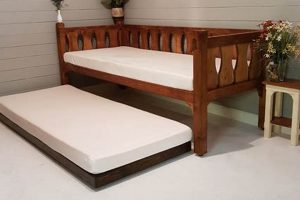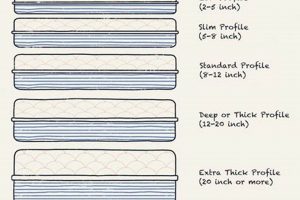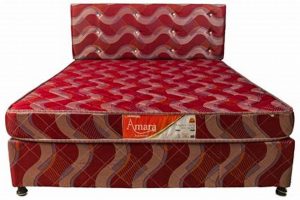The selection of a suitable sleep surface is paramount for ensuring restorative rest, particularly when considering the main sleeping area. Factors like support, comfort, and durability play critical roles in optimizing sleep quality. A well-chosen sleep surface can contribute significantly to overall well-being and daily functionality.
Utilizing a product designed specifically for regular use in a primary sleeping space offers distinct advantages. These advantages may include enhanced spinal alignment, reduced pressure points, and increased longevity compared to general-purpose alternatives. Historically, the evolution of these products reflects a growing understanding of the link between sleep and health.
The subsequent sections will delve into crucial considerations for selecting a sleep surface tailored for the main bed. These considerations include material composition, construction techniques, and relevant certifications, ultimately enabling a more informed purchase decision.
Selecting an Optimal Sleep Surface for the Primary Bed
The following guidelines are designed to facilitate a well-informed decision when choosing a sleep surface intended for regular use in the main sleeping area. Prioritizing these considerations will contribute to a more restful and supportive sleep experience.
Tip 1: Assess Individual Support Needs: Evaluate preferred sleep positions and body weight. Individuals with different body types and sleep preferences require varying levels of support. For example, side sleepers often benefit from a softer surface that contours to the body, while back sleepers may require firmer support.
Tip 2: Consider Material Composition and Durability: Investigate the materials used in the construction, focusing on density and resilience. Higher density materials generally exhibit increased longevity and resistance to sagging. Natural latex, for instance, offers durability and breathability.
Tip 3: Evaluate Motion Isolation Properties: Determine the degree to which movement is isolated to one area of the surface. This is particularly relevant for individuals sharing a bed, as it minimizes disturbance from partner movement. Pocketed coil systems often excel in motion isolation.
Tip 4: Prioritize Breathability and Temperature Regulation: Examine the materials’ ability to dissipate heat and promote airflow. Overheating during sleep can disrupt sleep cycles. Wool, cotton, and open-cell foam are materials known for their breathability.
Tip 5: Verify Certifications and Safety Standards: Confirm compliance with relevant safety and environmental standards. Certifications such as CertiPUR-US ensure the absence of harmful chemicals and volatile organic compounds (VOCs).
Tip 6: Read Reviews and Compare Information: Study the market offering to be aware of pros and cons. This information can be valuable in avoiding future inconvenience and waste of money.
Tip 7: Take Advantage of Trial Periods: Many retailers offer trial periods. This allows individuals to experience the surface firsthand and assess its suitability before making a final commitment.
Selecting a sleep surface for the primary bed requires careful consideration of multiple factors. By prioritizing support, durability, breathability, and safety, individuals can significantly improve their sleep quality and overall well-being.
The subsequent section will address common misconceptions associated with sleep surface selection, providing further clarity and guidance.
1. Support and Alignment
The relationship between support, alignment, and a mattress intended for primary bed use is fundamental to sleep health. The primary function of a mattress is to maintain the spine’s natural curvature, minimizing pressure points and promoting musculoskeletal health. Insufficient support leads to spinal misalignment, potentially causing back pain, stiffness, and disrupted sleep. Conversely, a mattress that provides adequate support ensures the body’s weight is distributed evenly, reducing stress on joints and muscles.
The effectiveness of a mattress in providing support and alignment is directly correlated with its internal construction and materials. For instance, mattresses incorporating zoned support systems, where different areas of the mattress are engineered with varying firmness levels, cater specifically to different regions of the body. This design addresses the need for firmer support in the lumbar region and softer support for the shoulders and hips, facilitating optimal spinal alignment. Similarly, materials such as memory foam and latex conform to the body’s contours, offering personalized support and minimizing pressure points.
The selection of a mattress that prioritizes support and alignment for primary bed use represents a long-term investment in physical well-being. By ensuring the spine maintains its natural curvature throughout the night, individuals can mitigate the risk of developing chronic pain conditions and improve overall sleep quality. Understanding the cause-and-effect relationship between mattress characteristics and spinal health is therefore paramount in making an informed purchase decision. Choosing a mattress that delivers the appropriate support and alignment is important.
2. Material Durability
Material durability directly impacts the longevity and performance of a mattress intended for primary bed use. The constituent components of the sleep surface dictate its ability to withstand constant pressure, resist degradation, and maintain its supportive properties over an extended period. Inferior materials lead to premature sagging, loss of firmness, and diminished comfort, ultimately necessitating replacement and incurring additional costs. For example, a mattress utilizing low-density foam may exhibit significant compression and reduced support within a year or two, particularly in areas bearing the most weight.
The correlation between material quality and durability is exemplified by comparing mattresses constructed with high-density latex or premium-grade memory foam to those using conventional polyurethane foam. Latex and high-density memory foam possess inherent resilience and resistance to deformation, allowing them to retain their shape and supportive characteristics for several years. Furthermore, the type of coil system employed within an innerspring or hybrid mattress contributes significantly to its overall durability. Individually wrapped or pocketed coils minimize motion transfer and distribute weight more evenly, reducing stress on individual components and extending the lifespan of the mattress.
In conclusion, selecting a mattress with robust materials is essential for maximizing its lifespan and ensuring consistent performance. Prioritizing durability not only provides long-term cost savings but also contributes t
o sustained comfort and support, which are vital for restful sleep and overall well-being. An awareness of material properties and construction techniques empowers consumers to make informed decisions and invest in a sleep surface that meets their needs and withstands the rigors of daily use within the primary sleeping area. This understanding helps avoid the need for frequent replacements.
3. Temperature Regulation
Temperature regulation within a primary bed environment significantly influences sleep quality. Maintaining a stable and comfortable sleep temperature prevents disruptions caused by overheating or excessive cooling, thereby promoting deeper and more restorative rest. The mattress plays a crucial role in this process, influencing heat retention and airflow around the sleeper’s body.
- Material Breathability
The breathability of mattress materials directly affects temperature regulation. Open-cell foam structures, natural latex, and materials like wool or cotton allow for increased airflow, facilitating the dissipation of body heat. Conversely, dense, closed-cell foams can trap heat, leading to discomfort and potential sleep disturbances. The choice of materials with inherent breathability is therefore paramount in ensuring a comfortable sleep temperature.
- Construction Techniques
Mattress construction methods contribute to temperature regulation. Hybrid designs, incorporating both coils and foam layers, often promote better airflow than all-foam constructions. Coil systems create channels for air circulation, preventing heat buildup within the mattress core. Similarly, the use of ventilated foam layers or convoluted surfaces enhances airflow and reduces heat retention.
- Cover Materials
The composition of the mattress cover influences temperature regulation. Covers made from breathable fabrics, such as Tencel or organic cotton, facilitate moisture wicking and promote airflow. Conversely, synthetic covers can impede airflow and contribute to overheating. Selecting a cover material that promotes breathability is essential for maintaining a comfortable sleep environment.
- Environmental Factors
Ambient room temperature and humidity levels impact the effectiveness of mattress temperature regulation. Even the most breathable mattress may struggle to maintain a comfortable temperature in an excessively warm or humid environment. Optimizing room temperature and humidity levels can complement the mattress’s temperature-regulating properties, creating a more conducive sleep environment. This could be achieved by using a fan or air conditioner, for example.
The interplay between material properties, construction techniques, cover materials, and environmental factors determines the effectiveness of temperature regulation. Optimizing these elements contributes to a more comfortable and restful sleep experience, enhancing overall health and well-being. Selecting a mattress with appropriate temperature regulation capabilities is crucial for ensuring a consistent and comfortable sleep environment.
4. Motion Isolation
Motion isolation represents a critical factor in the selection of a sleep surface, particularly for individuals sharing a primary bed. Effective motion isolation minimizes the transfer of movement across the mattress, reducing disturbances caused by a partner’s tossing, turning, or getting in and out of bed. This characteristic directly impacts sleep quality and the ability to achieve uninterrupted rest.
- Coil System Design
The design of the coil system significantly influences motion isolation. Individually wrapped or pocketed coils respond independently to pressure, minimizing the ripple effect associated with interconnected coil systems. For example, a mattress with individually wrapped coils will exhibit less motion transfer than one with a traditional Bonnell coil system. Mattresses should be checked for their built design, not just the material used.
- Foam Layer Density and Composition
The density and composition of foam layers contribute to motion isolation. High-density memory foam excels at absorbing movement and preventing its transmission across the mattress surface. Latex foam also offers good motion isolation properties due to its inherent resilience and ability to conform to the body’s contours. Thicker, denser foam layers generally provide superior motion isolation compared to thinner, less dense layers.
- Hybrid Construction
Hybrid mattresses, combining coil systems with foam layers, offer a balance of support and motion isolation. The coil system provides underlying support, while the foam layers absorb movement and reduce its transfer. The effectiveness of a hybrid mattress in isolating motion depends on the specific combination of coil type, foam density, and layer thickness.
- Edge Support
Edge support can indirectly affect motion isolation. A mattress with strong edge support prevents excessive sagging or roll-off, which can contribute to a feeling of instability and increased motion transfer. Reinforced edges provide a more stable sleep surface, reducing the likelihood of disturbances caused by movement near the perimeter of the mattress. Many brands offer this feature to create a more durable bed.
The combination of coil system design, foam layer characteristics, hybrid construction, and edge support determines the overall effectiveness of motion isolation. When selecting a mattress for a primary bed shared by two individuals, careful consideration of these factors is essential for minimizing sleep disturbances and optimizing rest quality. A thorough evaluation of mattress specifications and customer reviews can provide valuable insights into a mattress’s motion isolation capabilities. The mattress’ support can heavily influence the longevity of the bed.
5. Long-Term Value
The assessment of long-term value is crucial when selecting a mattress for a primary bed. This evaluation extends beyond the initial purchase price to encompass factors that influence the product’s overall cost-effectiveness and contribution to well-being over its lifespan. Understanding these elements facilitates a more informed decision, ensuring the investment aligns with individual needs and expectations.
- Durability and Longevity
A mattress’s lifespan significantly impacts its long-term value. Mattresses constructed with high-quality materials and robust construction techniques resist sagging, maintain support, and provide consistent comfort for an extended period. Investing in a durable mattress reduces the frequency of replacements, resulting in cost savings over time. For instance, a mattress with reinforced edges and a high-density foam core is likely to outlast a cheaper alternative with inferior materials, providing better value in the long run.
- Health and Wellness Benefits
A mattress that promotes proper spinal alignment, reduces pressure points, and facilitates temperature regulation contributes to improved sleep quality and overall he
alth. The long-term value extends beyond monetary considerations to encompass the positive impact on physical and mental well-being. Reduced back pain, improved sleep patterns, and decreased stress levels are tangible benefits associated with a supportive and comfortable mattress. Over the course of its use, a mattress that enhances sleep quality can have lasting positive effects on health and productivity. - Warranty and Customer Support
A comprehensive warranty and responsive customer support service enhance the long-term value of a mattress. A warranty protects against manufacturing defects and premature wear, providing peace of mind and assurance of product quality. Accessible and helpful customer support ensures that any issues or concerns are addressed promptly, contributing to a positive ownership experience. A longer warranty period often indicates the manufacturer’s confidence in the product’s durability and reliability, adding to its perceived value.
- Maintenance and Care Requirements
The ease of maintenance and care influences the long-term value of a mattress. Mattresses that are resistant to stains, easy to clean, and require minimal upkeep reduce the time and effort required to maintain their condition. Protective measures, such as using a mattress protector, can further extend the mattress’s lifespan and preserve its quality. A mattress that is simple to care for provides added convenience and contributes to its overall value proposition.
In summary, the long-term value of a mattress for a primary bed encompasses durability, health benefits, warranty protection, and ease of maintenance. By considering these factors, individuals can make informed purchasing decisions that align with their needs and expectations, ensuring a worthwhile investment in sleep quality and overall well-being. Selecting a mattress that offers lasting comfort, support, and reliability represents a sound financial and personal investment.
Frequently Asked Questions
The following addresses common inquiries regarding the selection and maintenance of mattresses intended for regular use in the main sleeping area. This information is intended to provide clarity and facilitate informed decision-making.
Question 1: What factors differentiate a mattress designed for primary bed use from other types of mattresses?
A mattress intended for primary bed use is typically engineered to withstand consistent, long-term use. This translates to more durable materials, enhanced support systems, and construction techniques designed to maximize longevity. Such a mattress should be able to offer long lasting and durable use.
Question 2: How frequently should a mattress intended for primary bed use be replaced?
The lifespan of such a mattress varies depending on material quality, usage patterns, and maintenance practices. However, a general guideline suggests replacement every seven to ten years. Visual signs of wear, such as sagging or indentations, and a decline in sleep quality indicate the need for replacement.
Question 3: What are the key considerations regarding firmness level when selecting a mattress for a primary bed?
Firmness level is a subjective preference; however, it should be guided by sleep position, body weight, and individual support needs. Side sleepers often benefit from a medium-soft to medium mattress, while back and stomach sleepers may prefer a medium-firm to firm mattress. A mattress must be comfortable enough to get good rest.
Question 4: How can mattress protectors extend the lifespan of a mattress intended for primary bed use?
Mattress protectors provide a barrier against spills, stains, dust mites, and allergens. By preventing these contaminants from penetrating the mattress, protectors help maintain its cleanliness and structural integrity, thereby extending its lifespan. Mattress protectors is an integral part of the mattress maintainance.
Question 5: What role does proper bed frame support play in the performance of a mattress for primary bed use?
Adequate bed frame support is crucial for preventing premature sagging and ensuring even weight distribution across the mattress surface. The bed frame should provide consistent support across the entire mattress area and be capable of bearing the combined weight of the mattress and its occupants. Bed frame directly affect the bed’s longevity.
Question 6: What certifications should consumers look for when purchasing a mattress for primary bed use?
Certifications such as CertiPUR-US indicate that the mattress foam has been tested for harmful chemicals and volatile organic compounds (VOCs). Other relevant certifications may address organic material content or sustainable manufacturing practices. Consumers should be sure to get certified bed that ensures safe usage.
Selecting and maintaining a mattress for the primary bed involves careful consideration of various factors. Adhering to these guidelines can contribute to improved sleep quality and prolonged mattress lifespan.
The subsequent section will address emerging trends in mattress technology and design.
Otis Mattress for Primary Bed
This exploration of the Otis mattress for primary bed has underscored the critical relationship between sleep surface selection and overall well-being. Key considerations such as support, durability, temperature regulation, and motion isolation have been examined in detail, emphasizing the importance of informed decision-making. The long-term value proposition, encompassing health benefits and product longevity, reinforces the significance of investing in a quality sleep environment.
The continued evolution of mattress technology and design promises further advancements in sleep optimization. As research deepens the understanding of sleep’s impact on health, individuals are encouraged to remain proactive in seeking sleep solutions tailored to their specific needs. Prioritizing sleep health is a critical step toward enhanced physical and cognitive function, ultimately contributing to a more productive and fulfilling life.


![Best Folding Murphy Bed Mattress [Guide & Reviews] Organic & Natural Mattress Buyer’s Guide: Non-Toxic Sleep Solutions Best Folding Murphy Bed Mattress [Guide & Reviews] | Organic & Natural Mattress Buyer’s Guide: Non-Toxic Sleep Solutions](https://mattressworldpa.com/wp-content/uploads/2025/07/th-7105-300x200.jpg)
![The Ultimate King Size Beds with Mattress [Guide] Organic & Natural Mattress Buyer’s Guide: Non-Toxic Sleep Solutions The Ultimate King Size Beds with Mattress [Guide] | Organic & Natural Mattress Buyer’s Guide: Non-Toxic Sleep Solutions](https://mattressworldpa.com/wp-content/uploads/2025/07/th-7104-300x200.jpg)


![Best Bed Car Mattress [Guide] Mobile Beds For Cars Organic & Natural Mattress Buyer’s Guide: Non-Toxic Sleep Solutions Best Bed Car Mattress [Guide] Mobile Beds For Cars | Organic & Natural Mattress Buyer’s Guide: Non-Toxic Sleep Solutions](https://mattressworldpa.com/wp-content/uploads/2025/07/th-7101-300x200.jpg)
